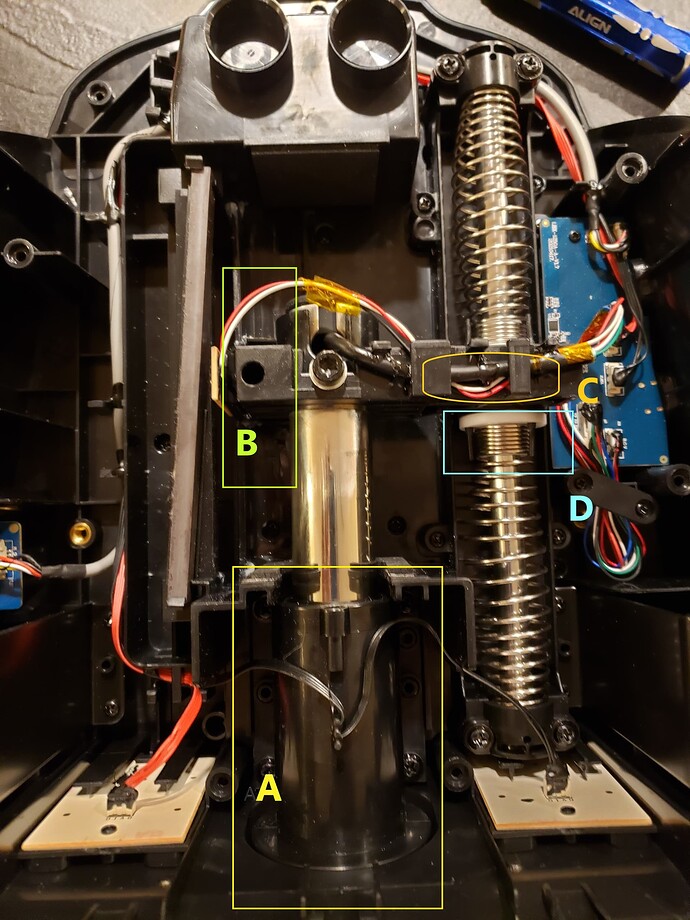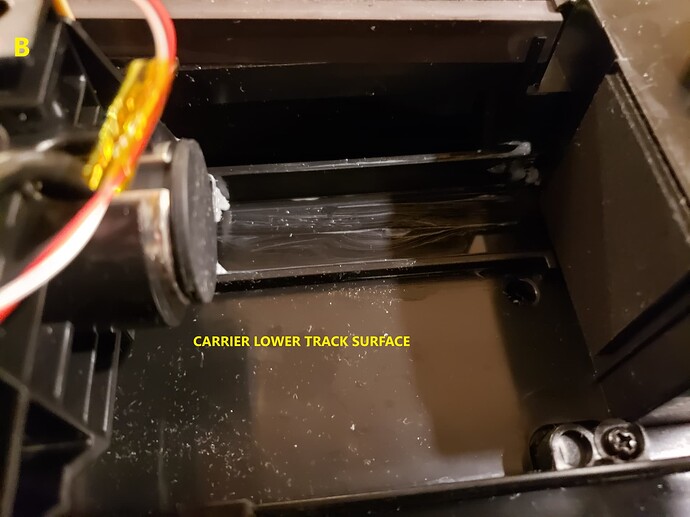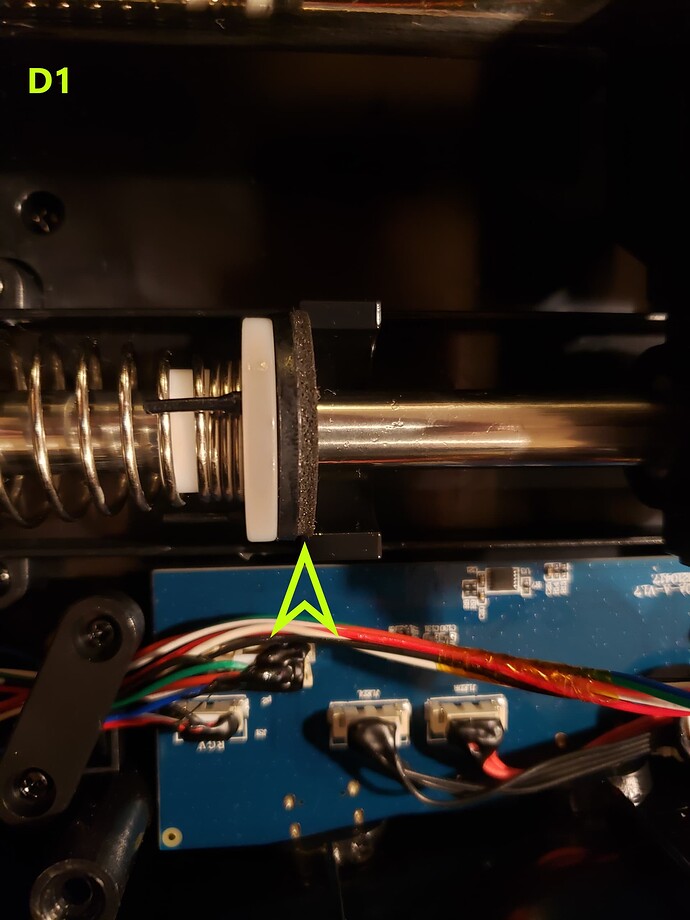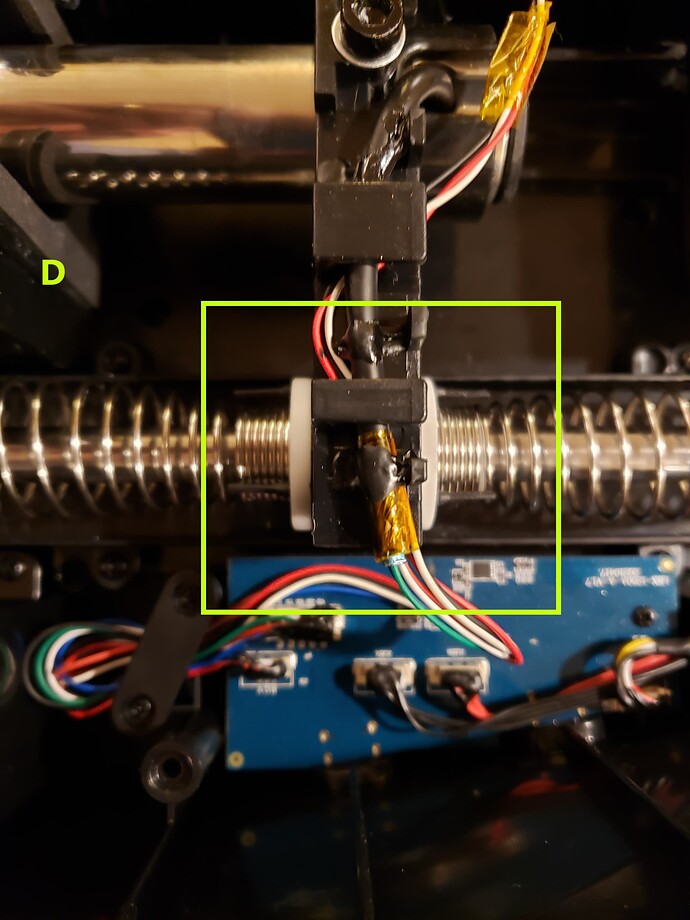Well it’s lunch so here goes. This is the problem with everything designed on CAD and not enough prototypes. First off, the peripheral is BRILLIANT, can’t imagine this much at this price on an xbox. Back when I chased so much less for thousands of dollars per year in computer gaming. No matter what my complaints/issues listed are, at this price point I do not expect metal or teflon bearings or anything else exotic. If this item worked PERFECTLY with upgraded internals and some more designer materials at $700+, I would still be in.
A: Is the main yoke support, with a nylon bushing surface inside. It has slop. By ITSELF, it does not bind. B: is the carrier/cassette that transfers load to the spring shaft(the small board to the left is the position sensor). This part sits in a track on the bottom, but has no support on top. This allows it to rocker its forces in a triangle with C/D spring shaft and bushings, which do NOT have much slop. And here within is where it binds.
In the world of CAD, I guess it was assumed that it would always be pulled back perfectly along the yoke shaft axis. The only ‘fix’ would be a major design change. Either support A would need to be made from a firmer metal material with better bushings, or support B would need to be molded into the top case to keep the shaft moving as designed.
Nothing explodes or flies apart if you take the case off. It can be clamped and used with no issues with the top case off. I spent a LOT of time with this as any modifications were not reversible, so did not want to go ‘too far’. in one test. So took this thing apart a lot of times. First was general examination, testing as is. A lot with the case off so I could fly around and IMMEDIATELY stop and see inside the box what I was feeling when not trying to make anything ‘happen’. Also, when ‘testing’ we tend to push the yoke ALL the way in and ALL the way out, when in reality we’re moving it 1/4" and holding, then gently releasing. All the ‘binding’ that feels so bad happens in a tiny amount of travel(at 200+ kias it’s not so ‘tiny’ to move the yoke 1/8"). THIS IS ONLY FOR MY PARTICULAR UNIT AND I DO NOT RECOMMEND ANY OF THIS…
For each part I also tested CLP, Ceramic grease, Lithium white grease, and various other lubricants. I settled on Ceramic R/C car grease(common in Tamiya RC cars). The materials are similar.
A: Yoke shaft, using a quality plastic safe grease(RC Ceramic) helps slightly. Fairly loaded on the inside. Outside only goes in a small amount. The inner bearing surface sees a higher load/angle. I did not disassemble any of it. There’s no real fix, but it helps. This does not fix binding.
B: Carrier/Cassette Track, a little grease on the contact surfaces. Just a dollop on each rail and let it find it’s way. It’s not in full contact everywhere. Helps a little bit. Also does not help binding, just fidelity.
C: The problem child itself. Inside the carrier on the spring shaft is a bushing. The spring shaft must be removed to access it. To see if this is the primary suspect, I outright removed it first and tested. The carrier slops up and down when turning but 80% better. There are slight ridges in the mold(see the wear marks). And that is after initial sanding. They BITE at the slightest off-angle. I started extremely mild and ended up opening it substantially, possibly a MM or more. Gave up on 3k/4k and went to 450 than 1200 then back to the finer stuff. I did some slight additional shaping to chamfer the edge and open the outer part slightly more, as the bushing rests to the outside of the force(some of it just me being fancy).
D: The spring support bushings have these spongy additional washers added(D1). They have adhesive on the backs but some has leached through the foam and where it rests in it’s center cradle, it slightly bites in and sticks a little(D1). D1 Shows the center point with the carrier moved out of the way. Again we are talking minutia of movement so we sense that tiny ‘stick’, react, and then feel the bind, etc. I dumped the sponges. The bushings on the spring shaft also have a little bite if the slightest bit off center(molding not the greatest and plain industrial nylon, not Teflon impregnated fancy stuff). So cleaned those up, nowhere near as dramatic as the carrier bushing. Had some minor binding issues with the same ridges in the mold. Just kept tweaking it until it didn’t grab at the slightest off-center movement. Lubricated with ceramic grease.
Another issue is the springs. Again designed in a vacuum of CAD, they are ‘perfectly’ designed to only work perfectly. I VERY CAREFULLY lengthened them about 10-15% for more positive centering. They are progressive wound and excellent for keeping the same ‘tension’ throughout the pull and you really need to be carefully lengthening a spring(can’t say I recommend trying this).
The spring shaft bushings needed the ‘slop’ to accommodate slop from the yoke. The design of the center spacer area still does not allow 100% centering, but I can’t imagine anything with a center point under tension from both sides to be 100% perfect, a controller joystick certainly does not. There is still a padded face to the spring stops, so it does have a tiny variable of it’s compression depending on how it’s ‘set’ to that center rest. So I go with 3% dead zone and still about 37% of negative sensitivity on pitch(and rudder). Seems to balance forces well with the aileron input for forces applied naturally(not when you just stare at a dead peripheral and play with it).
This has removed all binding for me, even when you hold a position and or have it at ‘rest’, where both the sponge sticks and the bushing(particularly the ridges in the molds) ‘bite’ back down on the shaft. If you are lazy and rest downward pressure on the yoke, it will firm up the pull quite a bit(as the yoke bushing also tightens down on the angle substantially), but doesn’t ‘chug’ and skip on the shaft any more. Easy to get lazy resting on the yoke flying trim and tiny corrections, playing with camera hats, etc for 20 minutes before initializing an elevator input. Anything remotely ‘normal’- less then cranking down on the yoke- is butter smooth to match the other inputs.
Again, I don’t endorse this, just a moment in time.
And to be honest it wasn’t terrible out of the box but I’m ■■■■ picky. Spent too much time in hobbies getting 5 different linkages to all have the same amount of resistance at every ball joint for something to sit neutral just under it’s own weight.
Technically just tweaking the 3 nylon bearings for more clearance (and the ones in the yoke shaft for less) with better molds and plastic compound could go miles to helping things without re-inventing the thing. Wouldn’t be surprised if those get updated somewhere along the line. Now for those pesky ‘loose’ throttle levers…




